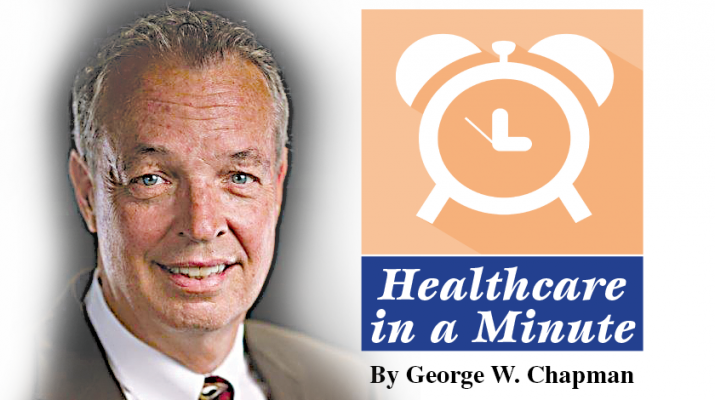By George W. Chapman
Hospital Ratings
The recent five-star ratings of hospitals by Medicare raised the issue of whether large teaching hospitals got a fair shake because the survey upon which the ratings were based (Hospital Consumer Assessment of Healthcare Providers and Systems) did not account for patient acuity. Large teaching hospitals treat more trauma and often care for difficult patients transferred to them by surrounding rural and suburban hospitals. A study published in the Journal of General Internal Medicine looked at online hospital reviews by consumers on Yelp. About 25 percent of the almost 3,800 hospitals in the Medicare survey also had ratings on Yelp. The correlation between the Medicare rating received by a hospital and the Yelp reviews was very strong. Yelp reviewers reported on staff quality and compassion, access, convenience, bedside manner, cost, billing, scheduling, treatment of family and visitors. Researchers found that consumers are more savvy than the industry thinks. Hospitals that performed better on both outcome and processes enjoyed greater market share and growth. Word gets around and patients seek care where it’s the best.
Telemedicine
Many argue telemedicine will never be as effective as a real face-to-face encounter between patient and provider. So far, the technology has proven effective in many scenarios, such as: the patient is incapacitated (sick, injured, contagious); foul weather; transportation is unavailable (commercial or caregiver); patient just needs remote monitoring; patient needs encouragement or compliance pep talk; patient needs medicine checked; patient has mental issues and acts out; patient can’t leave work; on call provider can refer to video visit.
RomneyCare update
Industry observers keep an eye on what is happening In Massachusetts because it is considered the harbinger of things to come under the Affordable Care Act. The Massachusetts Center for Health Information reported that costs in 2015 were $8,424 per capita which is an increase of 3.9 percent over 2014. The benchmark or target was an aggressive 3.6 percent. (Everyone in Massachusetts has insurance.) As with the rest of the nation, drug costs were responsible for most of the cost “overrun,” accounting for a third of all costs. Larger, more efficient healthcare systems are putting a lot of financial pressure on smaller community hospitals and rural systems.
2016 election
Both candidates agree drug companies seemingly raise prices arbitrarily and something needs to be done. Trump would allow Medicare/Medicaid and commercial payers to purchase drugs from countries like Canada. Clinton would appoint a federal watchdog to monitor price increases and limit the amount of income consumers would have to spend out-of-pocket on drugs. But controlling the pharmaceutical industry, let alone prices, will not be easy unless the revolving door between the FDA and the drug manufacturers is controlled. The FDA has data on how many of its former employees now work as consultants or lobbyists to the pharmaceutical industry but has not released such data.
National spending
In 2014, we spent $9,523 per capita on healthcare — still the most by far of any developed country. At $3 trillion, healthcare was 17.5 percent of our GDP in 2014. (It is currently trending at 18 percent.) Medicare and Medicaid accounted for 36 percent of spending. Commercial insurance accounted for 33 percent and out of pocket another 11 percent. The remaining 20 percent is VA, federal employees, Public Health Service and other federal programs.
Specialty rankings
According to a study of online physician reviews published in Becker’s Hospital Review, consumers report the highest satisfaction levels with neuromuscular specialists, thoracic surgeons, podiatrists, plastic surgeons and colorectal surgeons. The lowest ranking were with psychiatrists, preventive medicine specialists, pain specialists, emergency physicians and neurologists.
Physicians refusing care
A debate over how much autonomy a physician should have when he/she has a conscientious objection to providing a service like abortion, birth control, unnecessary testing and assisted suicide is published in the Journal of Bioethics. Those who argue a physician does not have the right to refuse care feel access to care, especially when there are few if any alternatives, must override a physician’s personal beliefs. Those who argue a physician does have the right to refuse care argue they are entitled to have values like everyone else. Sweden and France bar physicians from refusing any legal service and can suspend or revoke a practitioner’s license. The US, Canada and the UK have historically allowed the refusal of services based on conscientious objection. Most physicians who will not provide certain services due to moral objections will be happy to refer their patients to another provider without disrupting the overall relationship between them.
Watch your scale
The good news, according to a study by a Cornell professor published in the New England Journal of Medicine, is your weight might be at an annual low right now. The bad news is that, thanks to the upcoming holidays, you will gain weight and a lot of the gain will be permanent, if you don’t pay attention. Weight gain typically starts 10 days before the holiday season and peaks around New Year. Because the study participants were aware they were in a weight study, the professor believes the weight gains were probably artificially low to moderate and that weight gain in the general public is worse. Other studies have found that after 30, most of us gain two pounds of permanent weight every holiday season.
George W. Chapman is a healthcare consultant who works with hospitals and medical groups. He operates GW Chapman Consulting based in Syracuse. Email him at gwc@gwchapmanconsulting.com.

